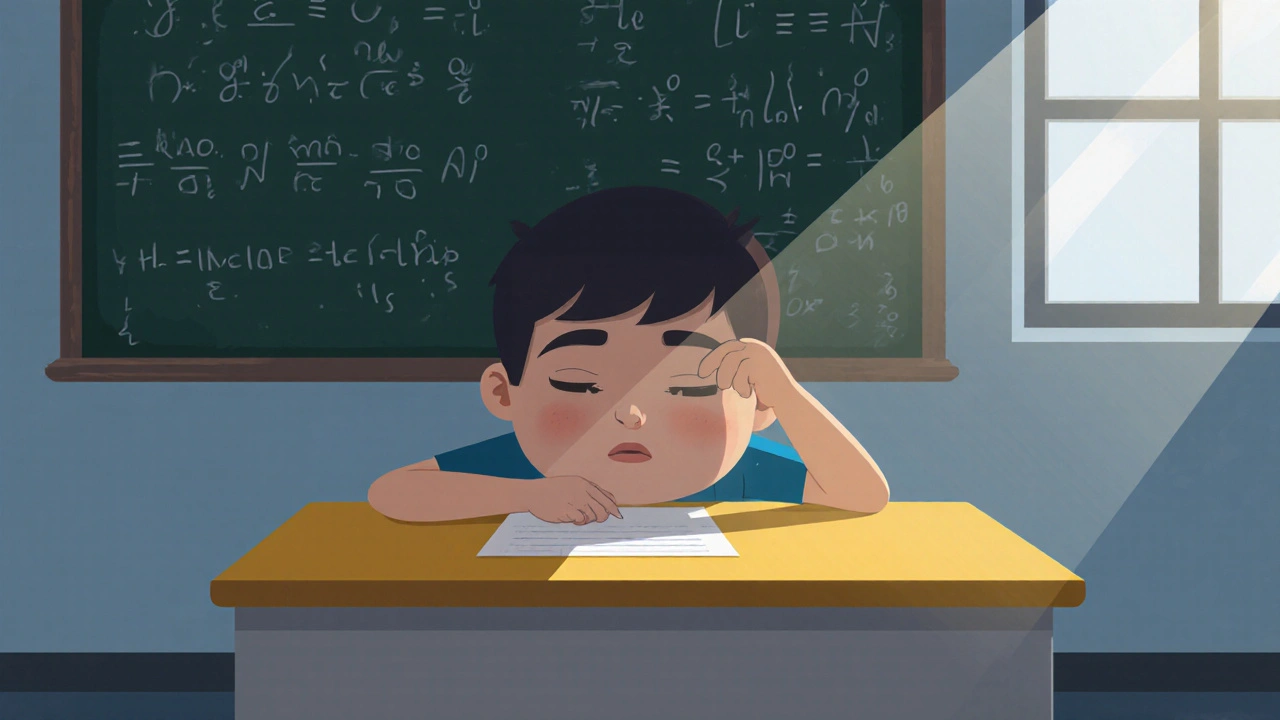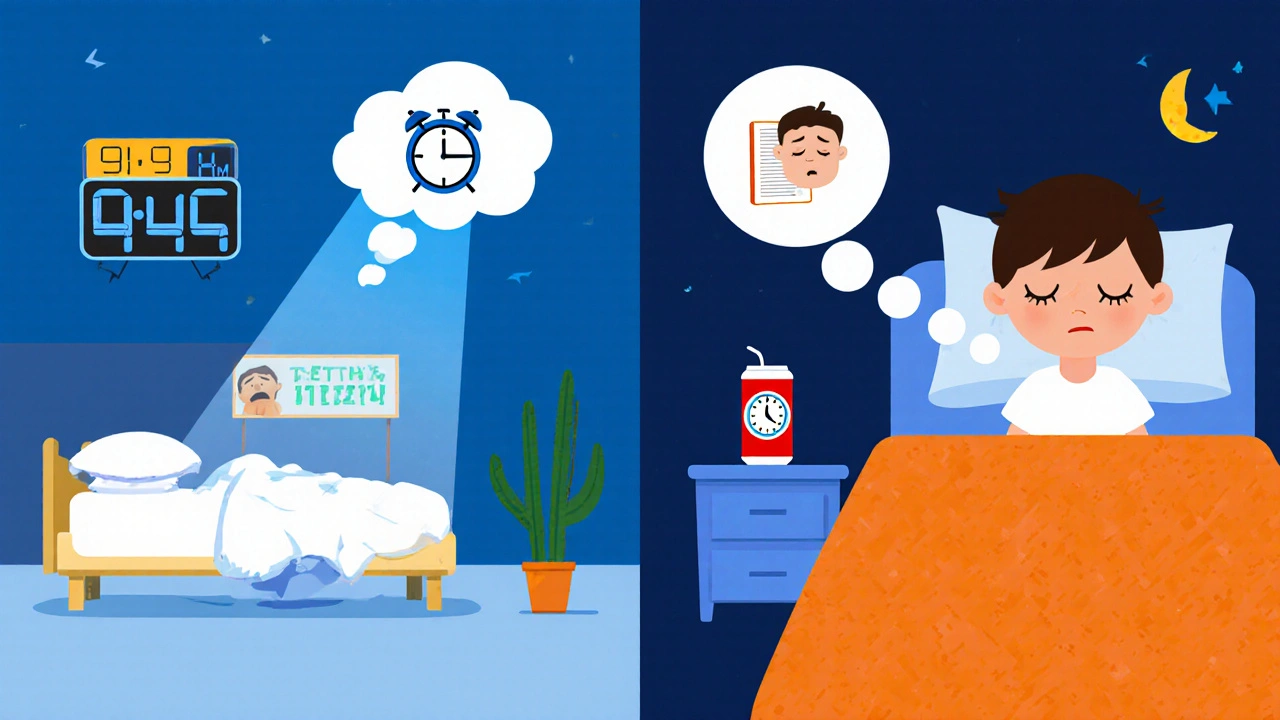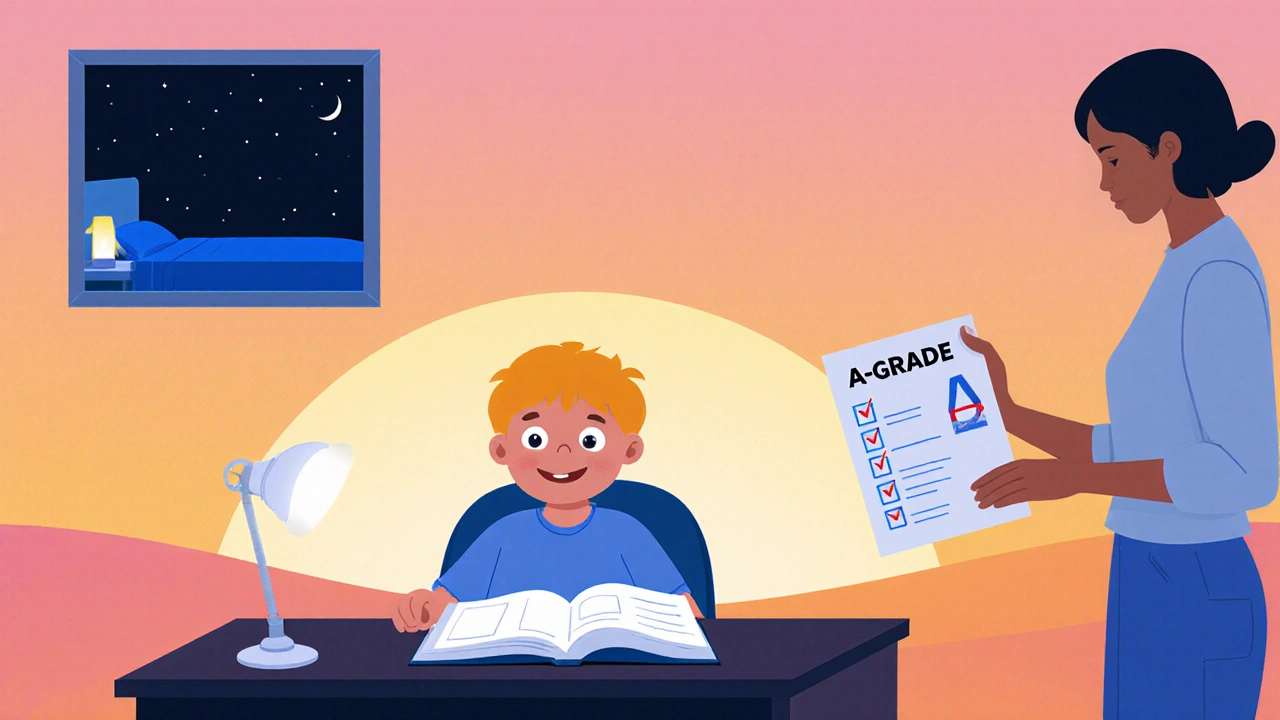
Child Sleep Calculator
How Much Sleep Does Your Child Need?
This tool estimates your child's sleep deficit based on age and compares it to recommended sleep amounts.
Quick Takeaways
- Kids who are constantly sleepy score lower on reading and math tests.
- Irregular bedtimes, excessive screen time, and untreated sleep disorders are the biggest culprits.
- Simple habits - consistent bedtime, dim lights, and a wind‑down routine - can boost attention by up to 30%.
- When sleep problems persist, a pediatric sleep study may be needed.
- Parents who model good sleep habits see the strongest improvements in their child’s grades.
Ever watched your child struggle to stay awake during class and wonder why the homework is suffering? That foggy feeling isn’t just “being tired”; it’s sleepiness interfering with the brain’s ability to learn. In this guide we break down how sleepiness drags down school performance, why it happens, and what you can do tonight to set your kid up for better grades tomorrow.
What Exactly Is Sleepiness?
Sleepiness is a physiological state of reduced alertness that makes it hard to stay focused, react quickly, or process new information. It’s different from short‑term fatigue after a busy day; chronic sleepiness signals that the body isn’t getting enough restorative sleep.
How Sleepiness Shows Up in the Classroom
When a child is sleepy, the brain’s executive function - the mental “CEO” that plans, prioritises, and switches tasks - starts to lag. This shows up as:
- Difficulty following multi‑step instructions.
- Frequent daydreaming or zoning out.
- Slower reading speed and poorer comprehension.
- Reduced working memory, making it hard to hold numbers in mind for math problems.
- Increased irritability, which can lead to classroom disruptions.
Research from the University of Queensland (2023) linked just one extra hour of sleep per night to a 7‑point rise in standardised test scores for Year 5 students. That’s a measurable jump that can shift a child from the lower quartile to the middle of the class.
Key Drivers of Child Sleepiness
Understanding the root causes lets you target the right fix. The most common drivers are:
- Irregular Bedtimes: Inconsistent sleep‑wake schedules disrupt the circadian rhythm, the internal clock that tells the body when to be alert.
- Excessive Screen Time: Blue light suppresses melatonin, the hormone that signals it’s time to sleep.
- Underlying Sleep Disorders: Conditions like sleep apnea or restless‑leg syndrome often go unnoticed in kids.
- Stress & Anxiety: Worries about schoolwork can keep the brain in a hyper‑alert state, delaying sleep onset.
- Late‑night Caffeine or Sugary Snacks: These spike energy briefly but crash later, increasing daytime drowsiness.
Biology in Plain English: Why Sleep Matters for Learning
Two major processes happen while we snooze:
- Melatonin the sleep‑inducing hormone that rises as darkness falls tells the brain it’s safe to switch off.
- Circadian rhythm the 24‑hour cycle that regulates sleep, hormone release, and body temperature ensures deep, restorative sleep phases occur at the right time.
When deep sleep (especially slow‑wave sleep) is cut short, the brain can’t consolidate memories, weakening the link between what was learned and what can be recalled during a test.

Spotting the Warning Signs
Kids can hide their tiredness, but teachers often notice these patterns:
- Consistently falling asleep in the first half of the school day.
- Sudden drop in grades despite unchanged effort.
- Complaints of “headaches” or “stomachaches” that improve after a nap.
- Struggles with social interaction due to irritability.
If you hear two or more of these signs, it’s time to audit your child’s sleep habits.
Practical Strategies Parents Can Implement Tonight
Below is a quick‑reference table that outlines the most effective actions, why they work, and a tip to make them stick.
| Intervention | What It Does | Typical Age | Implementation Tip |
|---|---|---|---|
| Consistent Bedtime (same time daily) | Stabilises circadian rhythm | 5‑12 | Set a bedtime alarm on a family clock |
| Screen‑Free Zone 1 hour before bed | Allows melatonin to rise naturally | 6‑15 | Replace screens with reading or puzzles |
| Night‑time Routine (brush, story, lights dim) | Signals brain it’s time for sleep | 3‑14 | Use a visual checklist on the bathroom wall |
| Cool, Dark Bedroom (≤18°C, blackout curtains) | Supports deep sleep phases | All ages | Invest in a simple bedroom thermometer |
| Limit Caffeine/Sugar after 3 pm | Prevents energy spikes that delay sleep | All ages | Swap soda for water or milk |
Pick one or two items to start with. Consistency beats intensity - a routine that sticks for weeks yields better results than a perfect plan that lasts a day.
When Home Fixes Aren’t Enough
If your child’s sleepiness persists despite a solid routine, consider these next steps:
- Consult a Pediatrician: They can screen for sleep apnea, restless‑leg syndrome, or chronic insomnia.
- Sleep Study (Polysomnography): This overnight test tracks breathing, heart rate, and brain waves to pinpoint disorders.
- Behavioral Therapy: A sleep‑focused therapist can teach relaxation techniques and address anxiety that interferes with sleep.
Early intervention matters. Untreated sleep apnea, for example, is linked to lower IQ scores and poorer math performance in children aged 7‑10 (Journal of Child Neurology, 2022).
How Improved Sleep Translates to Better Grades
When a child finally gets the recommended 9‑11 hours of quality sleep, you’ll likely notice:
- Sharper attention during morning lessons.
- Faster reading speed and better comprehension.
- Higher scores on tests that require working memory, like multiplication tables.
- More confidence, leading to increased participation and homework completion.
One study in Sydney schools (2024) followed 150 students for a semester. Those who added a consistent bedtime gained an average of 5.3 points on the NAPLAN reading component, while the control group showed no change.
Putting It All Together: A Simple Action Plan
- Audit the current sleep schedule - write down bedtime, wake‑up time, and screen use for a week.
- Pick two changes from the table above and implement them for 14 days.
- Monitor school performance - keep a log of grades, teacher feedback, and any mood shifts.
- If no improvement, book a pediatric appointment and discuss a possible sleep study.
Remember, sleep is a habit, not a one‑off fix. Keep the routine flexible enough for holidays but strict enough for weekdays.

How many hours of sleep does a school‑age child need?
Children aged 6‑12 should aim for 9‑11 hours per night, while teenagers need 8‑10 hours. Consistency matters more than hitting the exact hour count.
Can a short nap after school improve attention?
A 20‑30 minute power nap can boost alertness without messing up the nightly schedule, but longer naps may cause grogginess and shift bedtime.
What’s the link between screen time and melatonin?
Blue light emitted by phones and tablets suppresses melatonin production, delaying the body’s natural sleepy signal by up to two hours.
When should I seek a professional sleep evaluation?
If your child still feels sleepy after two weeks of a consistent bedtime, or if you notice loud snoring, breathing pauses, or severe mood swings, book an appointment.
How does sleep affect memory consolidation?
During deep sleep, the hippocampus replays the day’s experiences, transferring them to long‑term storage in the cortex. Poor sleep interrupts this process, making recall harder.




Craig E
October 22, 2025 AT 12:24It is striking how the subtle veil of sleep deprivation can cloud a child's potential, much like a fog over a sunrise. When we honor the rhythm of night, we honor the mind's capacity to absorb knowledge. Consistency in bedtime, rather than sporadic late hours, nurtures the neural pathways that underpin reading and arithmetic. Moreover, the gentle dimming of lights signals to the brain that restorative rest approaches, fostering attention that can rise by a measurable margin. Parents modelling these habits become living exemplars, imparting both behavior and belief. In this light, the relationship between sleep hygiene and academic achievement becomes a shared journey rather than a solitary struggle. Let us therefore craft routines that celebrate both rest and learning.
Marrisa Moccasin
October 28, 2025 AT 06:17Did you ever notice how the schools push endless extracurriculars??? It's as if there's a hidden agenda-maybe to keep kids too busy for the real truth!!! Some say the government monitors bedtime habits through smart devices-yes, those cute night lights could be data collectors!!! Think about it-who benefits when our little ones are perpetually exhausted? The answer may be far more unsettling than a simple lack of sleep!!!
Taylor Haven
November 3, 2025 AT 01:10There is an undeniable moral imperative to safeguard the sanctity of a child's mind against the insidious encroachment of chronic sleep deprivation, for it is not merely a matter of fatigue but a profound ethical crisis that threatens the very foundation of future society. When a child drifts through the classroom in a haze, the betrayal is not only of the child but of the community that professes to nurture its youth. The culprits are manifold: a relentless push for academic achievement, the omnipresent glow of digital screens, and, most ominously, a covert network of vested interests that profit from the malaise of an exhausted populace. It is well-documented, albeit seldom discussed, that corporations manufacturing night-time electronics have lobbied against stricter regulations, ensuring their products stay in bedrooms while parents remain oblivious. Furthermore, the educational apparatus often glorifies late-night study sessions as a badge of honor, subtly reinforcing the narrative that sleep is expendable. This narrative is a construct, engineered to create a compliant workforce that can endure longer hours without protest. The physiological ramifications extend beyond diminished test scores; they deteriorate the prefrontal cortex, impair impulse control, and erode the capacity for critical thought. In essence, we are witnessing a systematic dismantling of cognitive resilience, one restless night at a time. The ethical dimension becomes stark when we consider that untreated sleep disorders in children can be linked to long-term mental health disorders, a cost that society unwillingly shoulders. Moreover, the data from pediatric sleep studies reveal a disturbing correlation between sleep irregularities and increased susceptibility to chronic illnesses, underscoring the urgency of intervention. Parents, as custodians of their children's welfare, possess a sacred duty to impose rigorous bedtime regimens, to curtail screen exposure, and to champion the cause of restorative sleep. To do otherwise would be tantamount to complicity in a grand design that profits from diminished human potential. It is incumbent upon educators to model healthy sleep habits, for their influence extends beyond curricula into the very habits that shape tomorrow's citizens. Communities must rally to provide resources for families struggling with sleep hygiene, lest the widening chasm of educational inequity be further exacerbated by nocturnal neglect. In summarizing this moral indictment, one must acknowledge that the battle for adequate sleep is a battle for the soul of our civilization, demanding vigilance, advocacy, and unwavering resolve.
Sireesh Kumar
November 8, 2025 AT 20:04Honestly, you’ve nailed the conspiracy angle, but let’s not forget that the simple truth lies in the bedtime story ritual-nothing beats a classic tale to lull the nerves. I’ve read countless studies, and the data screams that a predictable wind‑down can double attention spans. It’s almost theatrical how many parents think “just one more episode” won’t matter, yet the drama unfolds tomorrow in a sleepy classroom. So, set the stage: dim lights, soft music, and a calm voice. The performance ends with the lights out, and the applause is a refreshed mind ready to learn.
Jonathan Harmeling
November 14, 2025 AT 14:57It’s disheartening to witness the casual neglect of a child’s need for rest, especially when the evidence is as vivid as sunrise. We ought to rise above complacency and champion disciplined sleep schedules with zeal. The lack of a consistent bedtime is a silent betrayal of potential, and we must speak out, albeit gently, to restore balance.
Ritik Chaurasia
November 20, 2025 AT 09:50Listen up, folks! Across cultures, from the ancient Romans to modern Asian families, sleep is revered as a pillar of daily life. Yet here we watch a generation surrender to artificial light and cramming, ignoring centuries of wisdom. This is an affront to heritage and a direct assault on the future. We must enforce strict bedtime rules now, before our children become victims of a sleepless cultural decay!
Mary Keenan
November 26, 2025 AT 04:44Honestly, this whole “sleep routine” hype feels like another parental guilt trap.
Steven Young
December 1, 2025 AT 23:37It is unfortunate that many overlook the systematic manipulation embedded in modern parenting narratives nevertheless the data remains clear the sleep deficit is a calculated outcome of commercial interests
Kelly Brammer
December 7, 2025 AT 18:30The moral duty of a parent extends beyond feeding and schooling; it includes safeguarding the child's capacity for concentration through proper sleep hygiene. Neglecting this responsibility is tantamount to willful ignorance of the child's developmental rights.
Ben Collins
December 13, 2025 AT 13:24Sure, because everyone just loves a good midnight math session, right? Let’s all pretend that yawning in class is the new cool trend while the rest of us enjoy a decent night’s sleep.
Denver Bright
December 19, 2025 AT 08:17It’s interesting how the school's calendar seems to ignore the natural circadian rhythm that many families already respect at home, don’t you think?
Kelli Benedik
December 25, 2025 AT 03:10Oh my gosh, the nightmare of watching my kid nod off in algebra is like a tragic play 🎭✨-the lights dim, the audience (parents) gasp, and the curtain falls on another missed opportunity. It feels like the universe is conspiring against us, and I’m just a weary spectator 🍂💤.